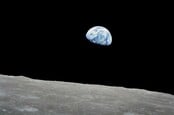This article is more than 1 year old
China celebrates third year of operations on the far side of the moon
Chang'e-4 and Yutu rover are still exploring, and NASA will need their support satellite
China has celebrated the beginning of a third year of exploration on the far side of the moon.
The Chang'e-4 probe touched down in the Von Kármán crater on January 3rd, 2019, making it the first human-made vehicle to make a controlled landing on the face of the Moon we can’t see from our home. The probe launched the Yutu rover about a dozen hours later.
They’re both still working today, which is remarkable because they’ve endured many of the Moon’s nights during which temperatures drop to below -170°C for a fortnight at a time, plus lunar days on which the mercury can reach 120°C or more. Yutu was designed to last a couple of those cycles but is still trundling and has become the longest-lived lunar robot.
China’s chuffed with the mission as a scientific endeavour because it met a main objective of identifying rocks felt to have originated from inside the Moon’s mantle, the layer beneath the crust. That find alone is thought to offer clues about the Moon’s formation and the origins of the planets.
The probe and rover have has also observed ejecta from meteor strikes, used radar to peer 40m down into the crust, and even find evidence of ancient basalt eruptions and distinguish the resulting material from the aforementioned ejecta.
There have also been problems: an on-board biosphere that China hoped would maintain a temperature of 24°C failed after nine of a planned hundred-day experiment. The biosphere did, however, manage to germinate seeds and send back some data about how they sprouted and grew.
A critical element of the mission is the Queqiao relay satellite, which was launched ahead of the lander and inhabits a halo orbit at the Earth/Moon L2 point from which it can see both Chang'e-4 and the Earth, thereby enabling real-time communications. Queqiao is one of just three missions to reach the L2 point and is such an asset that NASA requested to use it for future missions.
China granted that request, meaning that if NASA ever gets its Artemis moon shots flying, they may well rely on the Chang'e-4 mission - and find Chang'e-4 and Yutu still working. ®

